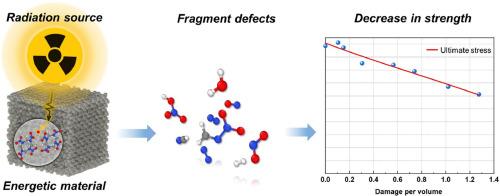Radiation defect formation and effect on mechanical property in octahydro-1,3,5,7-tetranitro-1,3,5,7-tetrazocine investigated by molecular dynamics method
IF 5.5
Q1 ENGINEERING, CHEMICAL
引用次数: 0
Abstract
Energetic materials (EMs) are generally used in various conditions including under the neutron irradiation environment. To understand the radiation damages and related effects on mechanical property of EMs is important and necessary for their further applications under radiation conditions. In this paper, the displacement cascades are firstly simulated with molecular dynamics method in an octahydro-1,3,5,7-tetranitro-1,3,5,7-tetrazocine (HMX) with the maximum energy of a primary knock-on atom (PKA) up to around 5 keV. The bond breaking, formation of free radicals, new gas molecules and interstitial and vacancy clusters, are all observed after displacement cascades, which can be used to explain the change of color and release of gas after irradiation as reported in experiments. Furthermore, the effect of above defect formation on mechanical property is calculated based on tensile stress simulations on damaged HMX. The results clearly show the appearance of strong stress gradient around defect formation region, resulting in lower external stress needed to deform the system. Thus, the radiation softening can be explored according to these results, same to experimental reports. Therefore, all these results indicate the radiation damages induced by energetic particles should be considered seriously for further application of energetic materials in nuclear conditions.

分子动力学方法研究八氢-1,3,5,7-四硝基-1,3,5,7-四佐辛的辐射缺陷形成及其对力学性能的影响
高能材料(EMs)通常用于各种条件下,包括中子辐照环境下。了解辐射损伤及其对电磁材料力学性能的相关影响对于电磁材料在辐射条件下的进一步应用是非常重要和必要的。本文首先用分子动力学方法模拟了八氢-1,3,5,7-四硝基-1,3,5,7-四佐辛(HMX)在一次击穿原子(PKA)的最大能量达到 5 keV 左右时的位移级联。在位移级联之后,可以观察到键的断裂、自由基的形成、新气体分子以及间隙和空位簇,这些都可以用来解释实验中报告的辐照后颜色的变化和气体的释放。此外,根据对受损 HMX 的拉伸应力模拟,计算了上述缺陷形成对机械性能的影响。结果清楚地表明,在缺陷形成区域周围出现了很强的应力梯度,导致系统变形所需的外应力降低。因此,根据这些结果可以探索辐射软化,这与实验报告相同。因此,所有这些结果表明,在核条件下进一步应用高能材料时,应认真考虑高能粒子诱发的辐射损伤。
本文章由计算机程序翻译,如有差异,请以英文原文为准。
求助全文
约1分钟内获得全文
求助全文
来源期刊

Chemical Engineering Journal Advances
Engineering-Industrial and Manufacturing Engineering
CiteScore
8.30
自引率
0.00%
发文量
213
审稿时长
26 days
 求助内容:
求助内容: 应助结果提醒方式:
应助结果提醒方式:


